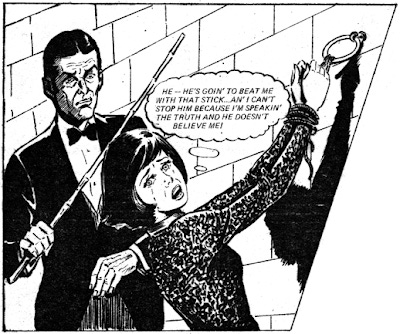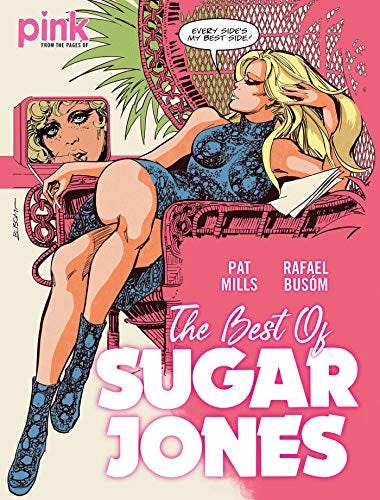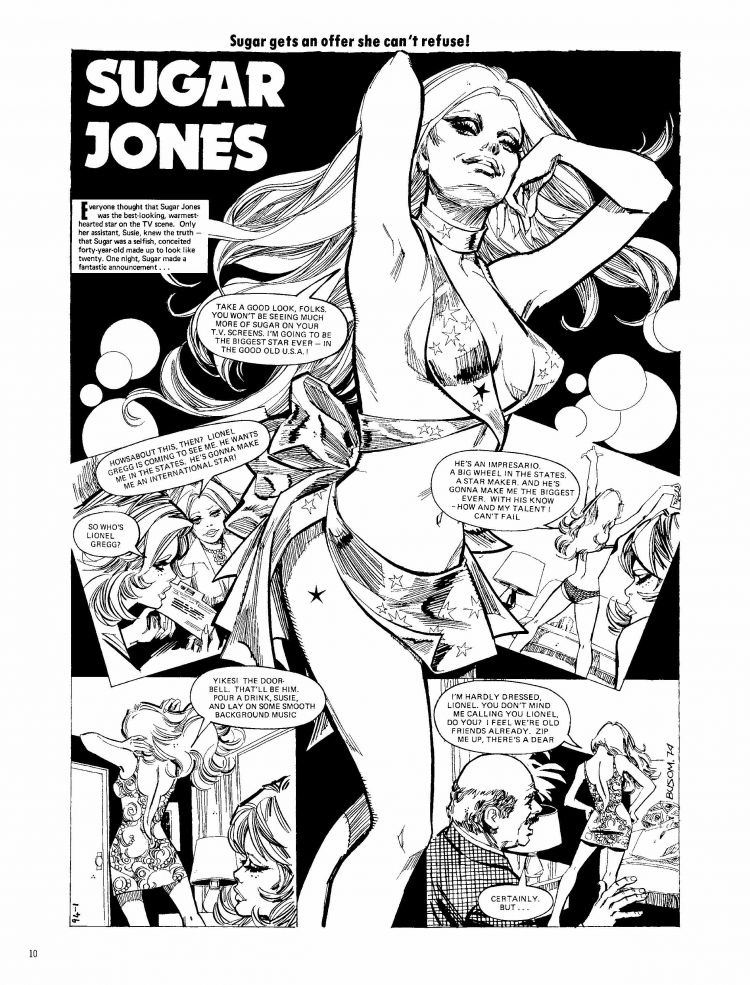Pageturners: Girls Comics Part 3
Although romance comics are often lumped in with girls’ comics, they were actually very different and appealed to a separate and rather older age group.
Welcome to Pageturners, a book I’m writing in which I share what I’ve learnt – and am still learning – about comic writing, film writing, novel writing and how new writers can sell their stories. I’ll publish a chapter or a section per week, available for free here on Iconoblast. And I welcome your feedback or questions, so do leave a comment below!
Missed the Pageturners intro? Read it here.
Just joining the party? Read Girls Comics Part 1 and Part 2.
HISTORICAL STORY
Victorian and Edwardian era stories were favourites. No Tears for Molly – a dark version of Upstairs, Downstairs ran for years and years. I’d originally thought that it might have been inspired by the show but the blogger at tammycomic.blogspot.com says that the strip predates it by six months. Given the success of Downton Abbey, I’m sure its equivalent would go down a storm today.
ANIMAL STORY
Horses, of course, have number one appeal in girls’ comics. D.C. Thomson even had a horse comic.
Any animal story, if it was well drawn, was likely to be successful. Thus Inky in Bunty, drawn by the brilliant Casanovas, about a cute puppy was a runaway success. It was delightful to read, too. John Wagner tried a similar cute cat story for Sandie, also drawn by Casanovas, but it didn’t go down so well. Probably because the cat’s head was anatomically correct but small in proportion to its body, so it wasn’t as cute as Inky.
I’ve talked about animal sanctuaries earlier in Pageturners and I’m convinced there’s a great story there.
EARLY TEENAGE STORY
These stories ran in Pink and were rather different to full-on romance comics such as Jackie and Romeo. They were still classic girls’ comic stories, but they had a cooler feeling than Bunty and Tammy.
My story Sugar Jones ran in Pink for years. Sugar is an ageing glamorous TV personality (a trendy version of Aunt Aggie – see above) who is super-cool, always jumping on the next pop bandwagon, but is actually a ruthless, cold-hearted, nasty bitch. It was very much in the style of Absolutely Fabulous and was drawn by Busom and Ramon Sola (Hook Jaw and Flesh). Rebellion tell me Sugar went down well with their female staff so that’s why it was reprinted.
ROMANCE COMICS
Although romance comics are often lumped in with girls’ comics, they were actually very different and appealed to a separate and rather older age group.
Romeo (which I worked on) and the million-selling Jackie were two of the leading examples of this genre. They could be rather drippy and I think they would be tough to revive for today’s streetwise audience, but not if they had a new spin on them like Twilight, vampires and werewolves in love, and the numerous variations on that theme.
See Ian Ashcroft’s Hellbreaker in Spacewarp described in the next section. He is a natural for this genre. And I believe we have a similar cross-species romance between an Infernal and the human cop sent to return him to Hell.
MISTY
A girls mystery and supernatural comic is probably the most likely and safest commercial bet.
It was the last few weeks before I left 2000AD and I was looking forward to starting work on my next creation: Misty. I took the title from the film, Play Misty For Me and my plan was to use my 2000AD approach on a girls’ comic: big visuals and longer, more sophisticated stories with the emphasis on the supernatural and horror. My role models were Carrie and Audrey Rose, suitably modified for a younger audience. The publisher, John Sanders, and I had several meetings to discuss its content and we could both see how it could be a hit; potentially bigger than 2000AD as girls comics sales were always higher than boys.
But given the success of 2000AD, I felt if I was going to create another hit for IPC juveniles, I should really have a share of the profits. John Sanders said his board of directors would never agree but I wouldn’t budge either. So I left and went back to freelancing. Later, I relented and agreed to be the consultant editor for Misty and guide it on its way. I also agreed to write the lead story for Misty – Moonchild – inspired by Carrie; and later Hush, Hush, Sweet Rachel, inspired by Audrey Rose, a story about reincarnation.
Without my direct involvement, the stories were not as hard-hitting as I would have liked them to be and some punches were pulled. I recall the horror endings of several of my stories were toned down which I think was a mistake. There were far too many short, self-contained stories, some a bit weak, not enough serials – which are vital to hook the reader.
Worst of all, more than a little “old school” thinking slowly starting to creep back in. Above all, there were no ongoing supernatural serials akin to Harry Potter, Twilight and Blue Bloods. Despite this, Misty was still very good, the art was fantastic – often better than 2000AD – and it was very much part of the Comic Revolution. Here’s how Will Brooker, author of Batman Unmasked and an expert on popular culture recalls Misty: “Pacts with the devil, schoolgirl sacrifice, the ghosts of hanged girls, sinister cults, evil scientists experimenting on the innocent and terrifying parallel worlds where the Nazis won the Second World War.”
Many Misty readers recall The Sentinels with particular affection. Malcolm, who sadly died very young, was same generation as John Wagner, myself and Gerry Finley-Day (creator of Tammy). Why was it mainly guys on girls comics, I hear you ask? Answer: because all the younger female magazine journalists looked down on girls comics and didn’t want to write or edit them, aspiring to teenage and women’s glossy magazines instead.
Another of his excellent Misty stories was Four Faces of Eve about a girl who looks absolutely normal but is really a female Frankenstein’s monster- she’s actually made up of four girls! That was a truly awesome and scary serial with great art by Brian Delaney.
I’ve always regretted not creating Misty the way I created 2000AD. I’ve little doubt if I had, it would still be around today and it could have changed the British comics landscape for the better.
Alas, Misty eventually died, for the reasons I’ve given. Fan approval for Misty today – no matter how effusive and insistent – should not distract us from the harsh realities of the causes of its demise. Individual, great one-off stories that fans rave about today are simply are not enough and don’t address commercial realities. Misty needed ongoing characters – like True Blood and The Hunger Games - to ensure reader loyalty.
At last it has been reprinted and Rebellion chose the right stories: Moonchild, Four Faces of Eve and more.
I understand Rebellion originated a Misty special, but haven’t heard anything since. It does require specialist writing – as I’ve described above – so I rather suspect that may have been missing.
It seems to me there is a chasm in the market for female comic readers and especially for mystery stories. This is born out by the various occult teenage series seen on Netflix.
FORMAT
I talked about an anthology earlier. It’s a lot of work, but there would be a lot of love for it if the creator got it right.
A simpler format would be a YA graphic novel. That would mean print on demand or good contacts in the book trade, notably in distribution. Above all, the art’s got to be great.
ARTISTS
The supreme girls’ comic artists were Casanovas (Ella on Easy Street) and John Armstrong (Bella and Moonchild). I love both their work. It’s well worth studying them and using them as a starting point if you want to draw girls’ comics or if you’re looking for a suitable artist. Note John Armstrong’s extensive range of facial expressions on his characters, far more than your average actor. He did this, he told me, by endless study and by using real-life models. The model on whom he based his best-selling Bella was very supportive of him in John’s final years.
I hope my tour of girls comics inspires someone to try producing one.
Heartstopper, a gay graphic novel, now a Netflix series, is in the girls comic tradition. It proves there is commercial potential for other Pageturners about the challenges of youth. I really hope someone goes for it.







